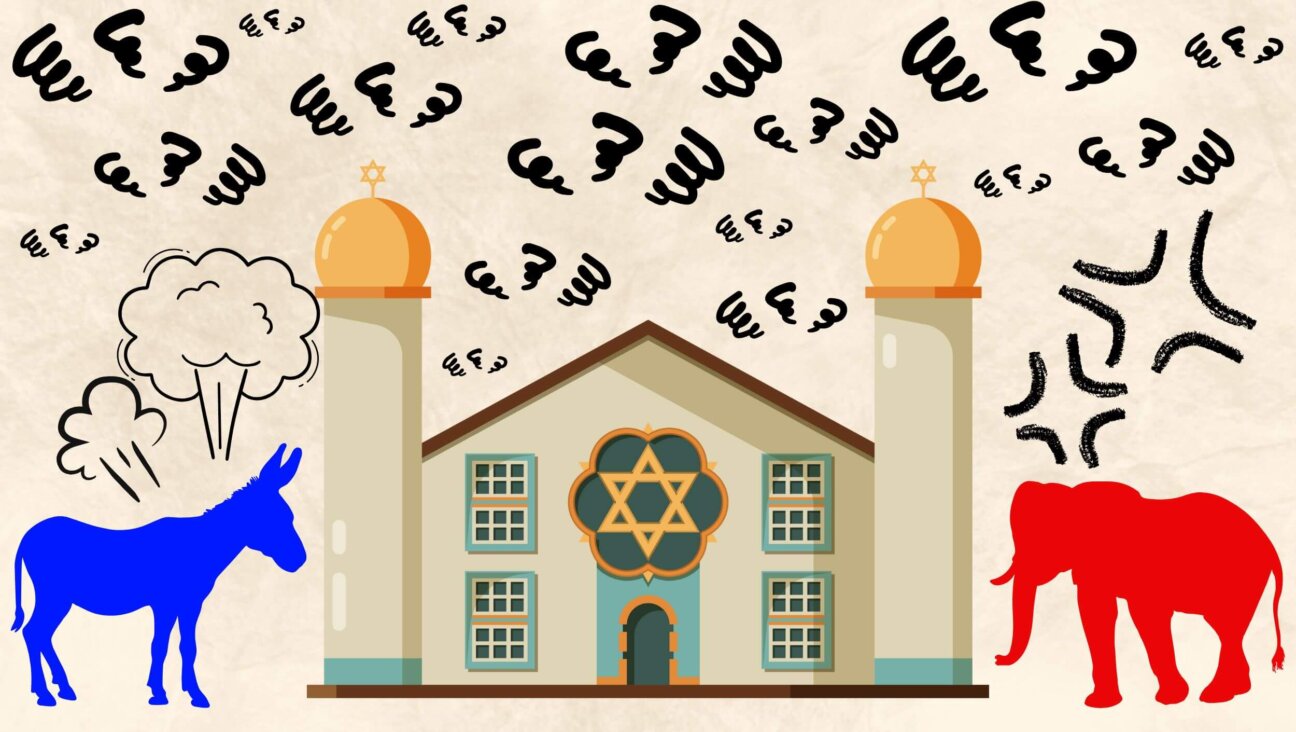Joseph Pilates invented a method. His Jewish lawyer helped make it a movement.

Joseph Pilates in his New York studio with a client. Image by Getty Image
In 1963, John Howard Steel was a 28-year-old Jewish attorney living in New York with a demanding law practice, an unhappy marriage, and a stiff neck.
One day, his mother urged him to find a cure to his aching neck. He walked into a gym run by a German immigrant named Joseph Pilates.
Pilates’ gym was filled with various medieval-looking apparatuses, lengthening and strengthening machines, that Pilates used for his new “Contrology” method.

John Steel, a bronze of Joseph Pilates, and Clara and Joseph Pilates, 1965. Image by John Steel
The machines, and a lifelong friendship with the man he called Joe, changed Steel’s life. And now thanks to his well-written and witty book, “Caged Lion: Joseph Pilates and His Legacy” (Last Leaf Press)it was a meeting that would change the way that the man behind the Pilates phenomenon is understood and remembered.
What many do not know — and what Steel’s memoir tracks so well — is that Pilates, the multi-billion dollar global fitness phenomenon, was founded during a period of profound social and economic turbulence not unlike what we are experiencing today.
Joseph Humbertus Pilates was an enigmatic German immigrant who arrived in New York in April 1926. His life before New York is shrouded in mystery.
World War I broke out in 1914 while Pilates was working as a circus tumbler in England. He and the members of his German circus troupe were taken into custody as enemy aliens and spent the duration of the war on the Isle of Man. In addition to leading the camp’s daily exercise routines to over 24,000 inmates, Pilates developed the ideas and movements that comprise the physical fitness system known as Pilates in prison, during moments of confinement.
“We know very little about Joseph’s time in the Knockaloe Prison on the Isle of Man,” said Steel in an interview with the Forward. “We don’t know why he went to Great Britain in the first place, but he obviously fled Germany for some reason. It probably had to do with the death of his wife. But he abandoned her son and their son—just left them with her parents and just fled.”
The state of the world, even on the cusp of World War I, had little interest for Pilates. All that mattered was the human body as a system, a tool, and what he then called the Contrology method he invented to fix all of its ailments, said Steel.
“My theory is that he spent his time learning about his body, the human body, and how it moved,” said Steel from his home in Santa Barbara, California. “My theory is that he also didn’t have any space when he devised the method. For four years he was probably confined pretty much of the time to a very small space.”
When Pilates left the prison, he returned to Germany and went back to boxing. “He failed. Boxing was legal in Germany provided there were no bets, but Joe Pilates was betting, and he got caught and got shut down,” said Steel.

Joe’s gym around 1940. From left: Joe Pilates, his niece, Mary Pilates, Clara Pilates, and an unknown client. Image by John Steel
The next segment of his journey brought him to New York. It was there that Pilates set up his studio on Eighth Avenue, a space where the few clients he had would learn Contrology.
Dancers, athletes and others who heard of the fitness method by word of mouth came to the studio. Clients would go to him with pain and he would know, almost instinctively, how to relieve it by applying one of his exercises. “As the person who worked his obscure magic to solve a physical problem that ofttimes doctors, chiropractors, or massage therapists couldn’t, he was a medicine man,” writes Steel. “Someone who worked miracles.” Steel’s neck ache went away. “Contrology took care of it,” Steel writes. “It wasn’t simply a physical feeling of well-being from exercise. My emotions and my mind seemed to get a cleansing.”
Steel and Pilates developed an unlikely friendship. Pilates was alone in New York except for his second wife Clara. They had no children and hardly any friends. Pilates was an eclectic, demanding friend, who thought nothing of bursting into the gym’s shower to show a man — or woman — the proper way to scrub. He also had strong opinions on sex — which he claimed his method vastly improved — and marriage — he counseled Steel to save his marriage by having affairs.
“He never had a big following,” said Steel. “At the time of his death, during which his following was on the decline, there may have 50 or maybe 100 people in the whole world that knew who he was.”
When Pilates died in 1967, Steel was part of a committee of Pilates’ clients that helped his wife, Clara, maintain the studio. The Pilates method, though, was largely transmitted through dancers, particularly his student Romana Kryzanowska who was first brought to Pilates by the choreographer George Balanchine, co-founder of New York City Ballet, after she suffered an injury while training at the School of American Ballet.
Steel took over the financial management of the fledgling studio, helping to keep it alive as Americans tried and discarded one exercise fad after another. Maybe that’s because, as Steel emphasizes throughout the book, Pilates is addictive. Something about Pilates kept him and other clients coming back over and over again to Joe’s gym.
Indeed, Pilates was convinced that one day his method would be practiced to such an extent that doctors and medicine would no longer be needed. That prediction, which Steel recounts Pilates stating on his deathbed, proved to be quite accurate, if a bit hyperbolic. Today, millions of people worldwide practice Pilates. His name and his method are everywhere.
Steel said the method, and the story behind it, are especially relevant to the times we are living.
“It was designed in confinement by confinement,” said Steel. He and Pilates would frequently go to the Central Park Zoo where Pilates would “observe with incredible intensity the caged lions and how they exercised.”
“It is a vacation of your body and your mind from your preoccupation with everyday living,” he continued. “This is a routine that requires total concentration. You can’t think about anything else while you do it.”
Perhaps that is what made Steel — and so many others — return to Joe’s gym.
























